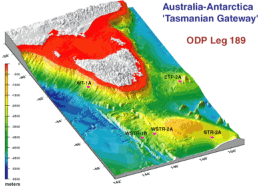
ODP Leg 189: The Tasmanian Seaway - Paleoclimate and Paleoceanography
Logging Summary
Leg 189 Shipboard Scientific Party
Introduction
The main objectives of ODP Leg 189 were:
Logging was conducted at four of the sites drilled on Leg 189 (Fig. 1): 1168 (WT1A); 1170 (WSTR2A); 1171 (STR2A); and 1172 (ETP2A). The logging tools used and the intervals logged are summarized in Table 1 below. The data are available from the ODP LDEO Well Log Database, although access will remain under moratorium until May 2001.
Figure 1 Map of Leg 189 site locations.
|
Hole |
Water Depth |
Depth Cored |
Interval Logged |
Toolstrings Used |
|
1168A |
2573 |
883 |
97-875.5 |
Triple Combo, GHMT-Sonic |
|
1170D |
2716 |
780 |
529-780 |
Triple Combo, GHMT-Sonic, FMS-Sonic |
|
1171D |
2159 |
959 |
151-959 |
Triple Combo |
|
1172D |
2631 |
766 |
150-762 |
Triple Combo, GHMT-Sonic |
Table 1 Table of drill sites, logged intervals and tools deployed
Results
The sequences logged included a range of late Cretaceous to late Neogene siliciclastic and biogenic sediments, deposited in a variety of environments. The results from all sites show that two distinct Cenozoic logging units exist in this region: 1) an upper unit characterized by low natural gamma, magnetic susceptibility, resistivity and a photoelectric value near 4 associated with the Oligocene to Quaternary pelagic carbonate deposits, and 2) a lower unit with higher natural gamma, magnetic susceptibility and lower photoelectric values associated with the Paleocene to late Eocene shallow-water siliciclastic deposits. These two logging units are well illustrated in the summary figure below.
Figure 2 Natural gamma-ray and resistivity logs from the four holes logged on ODP Leg 189.
The transition interval between the relatively homogeneous upper, and highly variable lower log unit varies in thickness by site, occurring abruptly at Sites 1171 and 1172 but more gradually at Site 1168. This transition is evident as a prominent reflector on the seismic sections, which correlates with a sharp increase in velocity in the downhole sonic log (e.g. Fig. 3).
Figure 3 Time/depth, p-wave velocity (Vp) and seismic data from site 1171. Many of the changes in Vp correlate with reflectors in the seismic section.
Correlative peaks in the density, resistivity, PEF, and K spectral gamma logs, associated with glauconite rich sediments (typical of sediment starved environments) are common in late Eocene sediments just below the transition to the overlying deeper, open ocean, carbonate deposits (see 1171 as example). This suggests that a period of slow sedimentation accompanied the opening of the Tasman Gateway during the late Paleogene.
Upper Logging Unit
Log parameters in the upper unit are fairly uniform with only small variations apparent in magnetic susceptibility, natural gamma, density, and resistivity indicating that relatively homogeneous, carbonate rich, pelagic sediments have accumulated since the Oligocene due to the deepening and opening of the Tasmanian Gateway. The small fluctuations in the natural gamma and susceptibility logs imply that, despite the predominance of pelagic carbonates, variations in the sediment terrigenous content occurred throughout the Neogene. Minor changes in the terrigenous component could result from variations in the supply and delivery of terrigenous material to the site or, alternatively, may represent changes in the overlying production of biogenic carbonates that dilute a relatively constant terrigenous supply. Discriminating between these various influences, each of which is related to different physical mechanisms with their own relationship to climate changes, will require detailed post cruise sediment geochemical studies.
Lower Logging Unit
In contrast to the relative stability of log parameters in the Neogene pelagic sequences, pronounced variability is evident in downhole logs within the underlying shallow water Paleocene to Eocene siliciclastic deposits. This lower sequence is characterized by a general increase in the downhole natural gamma logs with depth, suggesting the sediment terrigenous fraction increases with age at every site although the trend is most pronounced at the South Tasman Rise Site 1171. Likewise, the general increase in U spectral gamma logs with depth at Sites 1168, 1170, 1171, and 1172 suggests that the shallow water, siliciclastic Paleocene-Eocene deposits have higher organic carbon content than the overlying open ocean Neogene deposits. Yet, Th/U ratios of >2 suggest that the depositional environment, although less ventilated than the overlying pelagic carbonate sequence, was always either oxic or dysoxic. Superimposed on this general trend of increasing natural gamma values with depth are intervals containing higher frequency cyclic variations in the spectral gamma, magnetic susceptibility and resistivity logs at Sites 1170, 1171 and 1172 (e.g. Fig. 4).
Figure 4. Spectral gamma-ray data (A) and preliminary spectral analysis (B and C) from 1170D. The power spectrum show the results of spectral analysis over the entire logged section (B) and the interval where the Th and K data show the most pronounced cyclicity (C).
The regional persistence of these cyclic variations in the Th spectral gamma and magnetic susceptibility logs suggests a common influence on sedimentation, either through changes in sea level or regional climate which influenced sediment supply and/or delivery. Initial shipboard biostratigraphic results suggest that the period of these sediment cycles may be near 20 or 40 kyr using nannofossil and dinoflagellate datums respectively.
Leg 189 Logging Scientists
Ulysses Ninnemann: formerly at Lamont Doherty Earth Observatory, Route 9W, Palisades, NY 10964, USA.
Patrick Fothergill: formerly at University of Leicester, University Road, Leicester, LE1 7RH, UK, currently at Schlumberger.